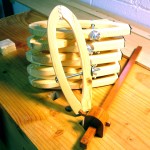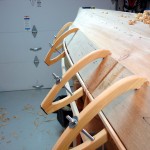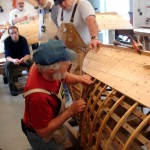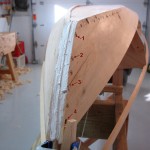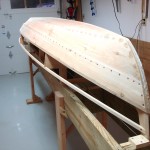
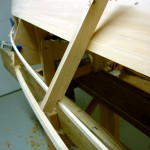 These went a lot faster than the garboard planks. No steam bending needed. There was a lot less white goop too; the dog walking down the street escaped with no goop this time.
These went a lot faster than the garboard planks. No steam bending needed. There was a lot less white goop too; the dog walking down the street escaped with no goop this time.
A couple of details are interesting. Lapstrake planks overlap at the edges. The “lap” on this boat is 5/8 inch and is, like the edge of the boat’s bottom, a rolling bevel. Getting the bevel right is pretty easy with the use of a temporary batten (that really thin piece) which simulates the edge of the next plank. Then stand a simple lap gauge between the batten and the existing plank to find the bevel angle. Plane along the bevel using the gauge to check for the right rolling angle. Keep the lap flat and free of crowns and all will fit well.
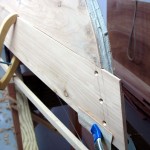 That is, until we get to the ends of the boat. There’s no overlapping at the ends. So, as we approach the ends, we plane a rabbet into the lap area of the garboard planks, and into the matching area on the middle planks. If one gets this rabbet to be half the plank’s thickness at the end of each plank, the result is nice and smooth at the stems. This area of transition is called “gains.” No, I don’t know the origin or reason for the term. My gains turned out fairly well.
That is, until we get to the ends of the boat. There’s no overlapping at the ends. So, as we approach the ends, we plane a rabbet into the lap area of the garboard planks, and into the matching area on the middle planks. If one gets this rabbet to be half the plank’s thickness at the end of each plank, the result is nice and smooth at the stems. This area of transition is called “gains.” No, I don’t know the origin or reason for the term. My gains turned out fairly well.
Fastening is with a few screws in the stem, adhesive caulk (3M 5200) at the stems and in the rabbets, and clinch nails every 2 inches.
